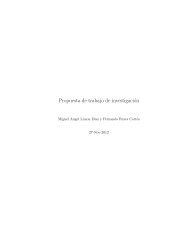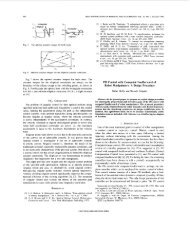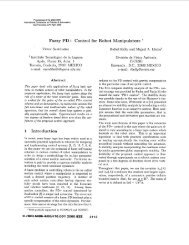1987 Harashima - Tracking Control of Robot Manipulators Using Sliding Mode.pdf
1987 Harashima - Tracking Control of Robot Manipulators Using Sliding Mode.pdf
1987 Harashima - Tracking Control of Robot Manipulators Using Sliding Mode.pdf
Create successful ePaper yourself
Turn your PDF publications into a flip-book with our unique Google optimized e-Paper software.
170 IEEE TRANSACTIONS ON POWER ELECTRONICS, VOL. PE-2, NO. 2, APRIL <strong>1987</strong><br />
T = [Tl, , Tn I" is the generalized external force. If the control inputs i1H and u; are selected such that si<br />
The Lagrangian L is expressed as and si always have the opposite signs in the neighborhood<br />
L = K(, O)-P(H) (2) <strong>of</strong> si = 0, that is,<br />
><br />
where P(6) denotes the potential energy <strong>of</strong> the system , 0 lim i < , (9)<br />
and K(6, 0) is the kinetic energy which is written as<br />
then sliding mode will occur on the switching surface si<br />
K = IOTR(6)b (3) = 0. Therefore, the state trajectories <strong>of</strong> the system will<br />
slide and remain on the surface, which implies that the<br />
where the inertia matrix R (6) is symmetric and positive motion <strong>of</strong> the system (6) is dominated by the sliding equadefinite<br />
for all 0.<br />
tion (7). Consequently, the original system, though it may<br />
Substituting (2) and (3) into (1), the equation <strong>of</strong> motion be higher order or nonlinear, behaves like a lower order<br />
for robotic manipulators can be written as and linear system defined by the sliding equation si = 0.<br />
(fn M( \ To<br />
I<br />
guarantee the existence condition (7) <strong>of</strong> the sliding<br />
R(H)H + L 0.<br />
0 -<br />
mode, one need only know the bounds <strong>of</strong> system param-<br />
e _R(6)&<br />
Ki=1 36j / 2 a6 eters for determining the control inputs (8). This clearly<br />
a means that the system is insensitive with respect to pa-<br />
+ - P(O) = T. (4) rameter uncertainties and other disturbances.<br />
Note that the second and third terms <strong>of</strong> the left side <strong>of</strong> the TRACKING CONTROL USING SLIDING MODE<br />
equation represent the Coriolis and centrifugal forces, and<br />
the last term denotes the gravitational forces. Equation (4) Two kinds <strong>of</strong> motions, the point-to-point (PTP) motion<br />
can take a more brief form and the tracking motion, should be considered. Usually<br />
the PTP motion may be regarded as a special case <strong>of</strong> the<br />
R(O)H + M(0) t + g(6) = T (5) tracking motion. Therefore, only the tracking problem is<br />
where<br />
considered here. The tracking capability <strong>of</strong> advanced ma-<br />
=}[06 0 0 022<br />
T nipulators is indispensable for the smooth motion required<br />
g = [,3P/0l, * * *aP/aOn]<br />
in various industrial tasks, such as in an assembly line<br />
T process. In tracking motion the values <strong>of</strong> desired position<br />
Od(t), desired velocity Ad(t), and the desired acceleration<br />
M = {mi,(6)}nx<br />
<strong>of</strong> the manipulator on the entire path are provided by a<br />
supervisory computer.<br />
1 = ln(n + 1). In this paper a new approach is developed to tracking<br />
motion control <strong>of</strong> manipulators.- Each arm is directly con-<br />
SLIDING MODE CONTROL trolled in the manipulator's coordinates (joint space).<br />
Moreover, the proposed method can be easily imple-<br />
<strong>Sliding</strong> mode control based on the theory <strong>of</strong> variable mented in a task-oriented space<br />
structure systems has a number <strong>of</strong> attractive features [7]. When manipulator motion is in low speed the super-<br />
Therefore, it is widely applied to solve various control visory computer is able to neglect those quadratic terms<br />
problems [11]-[ 15]. Consider the following system: 6,6A <strong>of</strong><br />
i<br />
. Then (5) would become<br />
H =f(O, t) + B(H, t)u (6) R(60)0 + g(0) = T. (10)<br />
where 6 e Rn x I, fe Rn x', B E Rn xm, and u E Rmxl. To The desired input torque is computed from<br />
obtain the desired dynamic performance <strong>of</strong> the system, a<br />
set <strong>of</strong> sliding mode equations is previously selected as T = R(6) {I -Kd -Kpe} + g(6) (11)<br />
si(0, t) = 0, i = 1, * , m (7) where Kd and Kp are constant gain matrices. Equations<br />
which defines the switching surfaces. Then the control in- (10) and ( 1) give<br />
puts with discontinuities have been decided according to R(6) { e + Kde + Kp e } = 0 (12)<br />
the switching logic as where e = 6 -<br />
(u+(6, t), if s460, t) < 0 Since the inertia matrix R(6) is nonsingular except in<br />
u1(6, t) = _.(8) some special cases, we may choose Kd and K,p such that<br />
yu, (6, t), If si(6, t) > 0 the characteristic roots <strong>of</strong> (12) have negative real parts,<br />
where u1 (6, t) is the ith component <strong>of</strong> u. The preceding and the error e approaches zero asymptotically.<br />
system with discontinuity control is termed a variable Notice that the effectiveness <strong>of</strong> the preceding control<br />
structure system since the feedback structure <strong>of</strong> the sys- algorithm is grounded on the premise that the manipulator<br />
tem is switching alternatively according to the state <strong>of</strong> the is in low-speed motion, whereas in most cases the manipsystem.<br />
ulator is required to track preplanned trajectories in high






